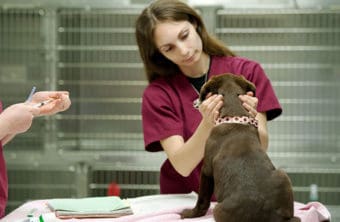Veterinary Assistant Job Description
Veterinary assistants work in all phases of animal care, including surgical nursing, laboratory procedures and office administration. Veterinary assistants wear many hats, some of the most commonly performed duties are bathing animals and cleaning the facilities, holding animals during procedures, collecting and processing samples for laboratory tests, and front office support. Employment opportunities include positions in veterinary offices or hospitals, zoological facilities, aquatic, equine and retail pet supply or pharmaceutical companies.
Requirements and Responsibilities for Veterinary Assistant
- Prepares treatment room for examination of animals; restrains animals during examination, treatment, or inoculation. Administers injections, performs venipunctures, applies wound dressings, cleans teeth, and takes vital signs of animal. Requires a high school diploma or its equivalent. May be required to be certified/licensed. Familiar with standard concepts, practices, and procedures within a particular field. Relies on limited experience and judgment to plan and accomplish goals. Performs a variety of tasks. Works under general supervision of a veterinarian. A certain degree of creativity and latitude is required.
Do not involve yourself in the Doctor/owner conversation
DO NOT MAKE SUGGESTIONS OR COMMENTS TO THE DOCTOR IN THE EXAM ROOM WITH THE CLIENT
How to Become a Veterinary Assistant
For those who love animals, there are few jobs more rewarding than that of veterinary assistant. The compassionate presence of these professionals eases the experience of a visit to the vet for pets and pet owners alike. Veterinary assistants assist veterinarians with every aspect of animal care, and also help manage pet owners’ questions and concerns.
Veterinary assistants are responsible for keeping the animals under their care clean and safe. They bathe, clean and disinfect animal cages, sterilize surgical equipment and perform daily caretaking tasks such as feeding and weighing animals. They administer medications, collect blood, urine and tissue samples for testing, perform lab tests and monitor animals during surgery.
Vet assistants also perform the important task of maintaining the charts that document daily care. In addition to the animal care they provide, veterinary assistants also assist pet owners. They are often the first point of contact for clients, and as such set the tone for their experience.
Veterinary assistants educate pet owners about illnesses, medications and general care, and answer their questions and concerns. Pets are important members of the family in more than 60% of households in the United States today. As integral members of the veterinary care team, veterinary assistants have the reward and satisfaction of assisting these beloved companion animals and their owners.
Veterinary assistants work primarily in veterinary clinics and animal hospitals, and sometimes in laboratories located in research facilities. They work full or part time, and often have the option of flexible hours. Veterinary assistants who work in 24-hour facilities such as animal hospitals will have the opportunity to work evenings, nights, weekends or holidays. It is helpful to be in good physical shape in order to effectively lift, move or restrain animal patients as needed. The ability to focus and stay on task in a loud environment is also helpful, as other animals in the facility can become quite noisy.
Education
- Most veterinary assistants must have a high school diploma or GED. Some veterinary assistants choose to earn a certificate through a non-degree program, but certification is not required. Employers generally prefer to hire veterinary assistants who have an associate’s or bachelor’s degree in animal science.
Training
- Although some certificate programs provide hands-on training, most training occurs on the job. Colleagues in the workplace train vet assistants in the animal care and front desk administrative tasks. Basic animal care will include feeding, watering and examining animals for issues, cleaning and disinfecting cages and work areas, sterilizing laboratory equipment and surgical instruments, providing post-operative care, administering oral and topical medications, and preparing specimens for lab examination. Front desk task training will include managing records and assisting customers on phone and in person when they visit the clinic.
Necessary Skills and Qualities
- Most veterinary assistants love animals and have a passion for animal welfare. Veterinary assistants need good physical endurance during physically challenging workdays and adequate strength to restrain animals when needed. Patience and the ability to maintain calm are essential as the animals coming to the facility might be scared, stressed or in pain, which can result in erratic or aggressive behavior.
- Veterinary assistants must possess emotional strength, stability and maturity for those instances in which they must treat abused animals or euthanize those who cannot be returned to a reasonable quality of life. Good people skills also come in handy, as veterinary assistants are often the first point of contact for distressed animal owners.
Opportunities for Advancement
- Veterinary assistants advance their careers in animal welfare by obtaining further education. Some veterinary assistants choose to go back to school to complete an associate’s degree and become veterinary technicians. Others choose to complete a bachelor’s degree with pre-veterinary requirements, allowing them to apply to veterinary school. Acceptance to veterinary school is highly competitive, making experience working as a veterinary assistant a distinct advantage.
Article by Veronica Hackethal
- The veterinary industry continues to grow as pet ownership continues to increase in the US. Animal safety efforts and emphasis on responsible pet ownership have also increased the demand for veterinary assistants. According to the US Bureau of Labor Statistics, employment for veterinary assistants is expected to grow at a rate of 14% from 2010 to 2020, closely matching the overall average rate of job growth.
www.bls.gov
More on vet assistants :









